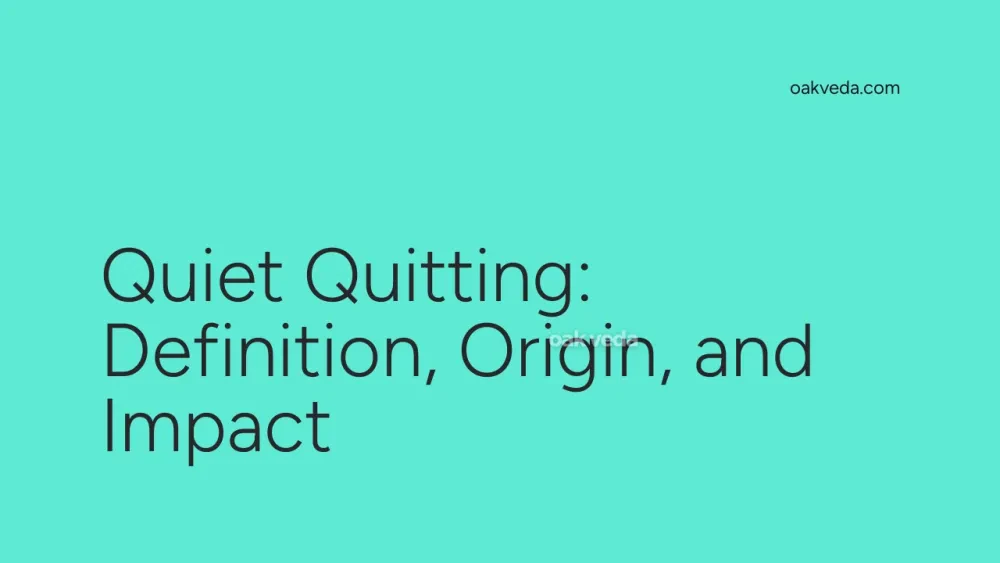
What is Quiet Quitting?
Quiet quitting is a workplace phenomenon where employees mentally check out of their jobs while still physically showing up for work. It's not about actually quitting, but rather doing the bare minimum required to maintain employment. This trend gained significant attention in 2022, particularly on social media platforms like TikTok, where workers shared their experiences and perspectives on disengaging from work.
Origin and Development of Quiet Quitting
The term "quiet quitting" emerged in the aftermath of the COVID-19 pandemic, which dramatically shifted workplace dynamics and employee priorities. While the concept of disengagement at work isn't new, the phrase gained traction in 2022, reflecting a growing sentiment among workers seeking better work-life balance and questioning traditional notions of hustle culture.
How Quiet Quitting Works
Quiet quitting manifests in various ways:
- Strictly adhering to job descriptions and work hours
- Declining additional tasks or projects
- Reducing engagement in workplace social activities
- Minimizing communication with colleagues and superiors
- Avoiding overtime or extra effort beyond contractual obligations
Importantly, quiet quitters aren't necessarily poor performers. They often continue to meet basic job requirements but resist going "above and beyond."
Types or Variations of Quiet Quitting
While not officially categorized, quiet quitting can take different forms:
- Passive Quiet Quitting: Gradually reducing effort and engagement over time
- Active Quiet Quitting: Consciously deciding to limit work involvement
- Temporary Quiet Quitting: Short-term disengagement due to burnout or specific workplace issues
Popular Examples of Quiet Quitting
Quiet quitting gained widespread attention through social media, particularly on TikTok. Users shared videos describing their experiences, offering tips on setting boundaries, and discussing the pros and cons of this approach. These viral posts sparked conversations about work culture, employee rights, and the changing nature of professional commitment.
Impact of Quiet Quitting on Workplace Culture
The quiet quitting trend has had significant implications for workplace culture:
- Increased focus on work-life balance and employee well-being
- Reevaluation of productivity metrics and performance expectations
- Greater emphasis on employee engagement and job satisfaction
- Shifts in management styles to address disengagement
- Discussions about fair compensation and workload distribution
Controversies and Debates Surrounding Quiet Quitting
Quiet quitting has sparked heated debates in professional circles:
- Generational Divide: Some view it as a millennial and Gen Z phenomenon, while others argue it's a universal issue
- Ethics: Questions about the morality of intentionally reducing work effort
- Productivity Concerns: Debates on how quiet quitting affects overall workplace productivity
- Career Impact: Discussions about potential long-term career consequences for quiet quitters
How Organizations Are Responding to Quiet Quitting
Companies are adapting their strategies to address quiet quitting:
- Implementing flexible work arrangements
- Enhancing employee recognition and reward programs
- Improving communication channels between management and staff
- Offering professional development and growth opportunities
- Conducting regular check-ins and satisfaction surveys
Future Trends Related to Quiet Quitting
As workplace dynamics continue to evolve, several trends are emerging:
- Emphasis on Employee Experience: Companies are likely to focus more on creating positive work environments to combat disengagement.
- Redefinition of Productivity: There may be a shift towards outcome-based performance metrics rather than time-based measures.
- Work-Life Integration: Organizations might adopt more holistic approaches to balance work and personal life.
- Mental Health Initiatives: Increased investment in employee mental health and well-being programs is expected.
- Skill-Based Hiring: Companies may prioritize skills and results over traditional notions of workplace commitment.
FAQs about Quiet Quitting
-
Is quiet quitting the same as being lazy? No, quiet quitting is more about setting boundaries and prioritizing work-life balance rather than laziness.
-
Can quiet quitting hurt my career? It may impact career growth if it leads to missed opportunities or negative performance reviews.
-
How can employers prevent quiet quitting? By fostering a positive work culture, providing growth opportunities, and ensuring fair compensation and workload.
-
Is quiet quitting a new phenomenon? While the term is new, the concept of employee disengagement has existed for a long time.
-
Can quiet quitting be a positive thing? It can lead to improved work-life balance and prompt important conversations about workplace culture and expectations.
In conclusion, quiet quitting represents a significant shift in how employees approach their work and career. As this trend continues to evolve, it's crucial for both employers and employees to engage in open dialogues about expectations, job satisfaction, and the changing nature of work in the modern era. By addressing the underlying issues that lead to quiet quitting, organizations can create more fulfilling and productive work environments for all.
You may be interested in:
- Gen Z: Definition, Origin, and Impact on Social Media
- Vlogging: Definition, Origin, and Impact on Social Media
- DM (Direct Message): Definition, Origin, and Impact
- Binge-Watching: Definition, Origin, and Impact on Social Media
- Chatbot: Definition, Origin, and Impact on Social Media
- Crispy R: Definition, Origin, and Impact on Social Media

